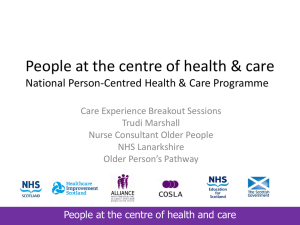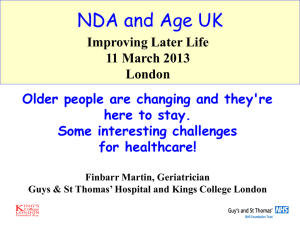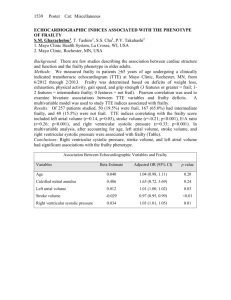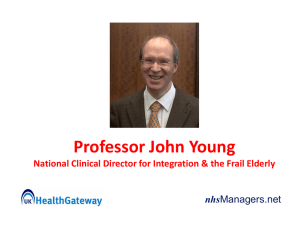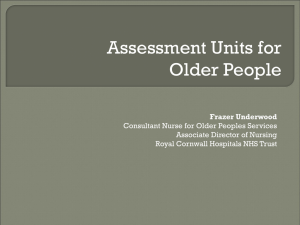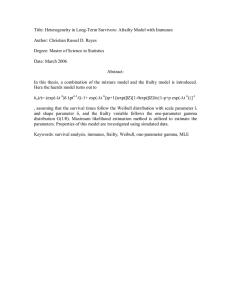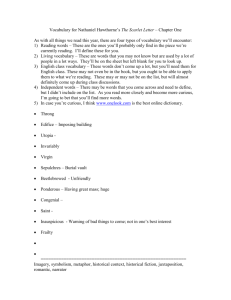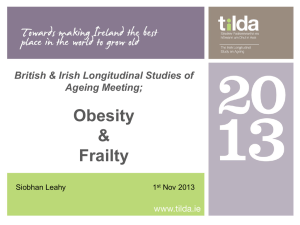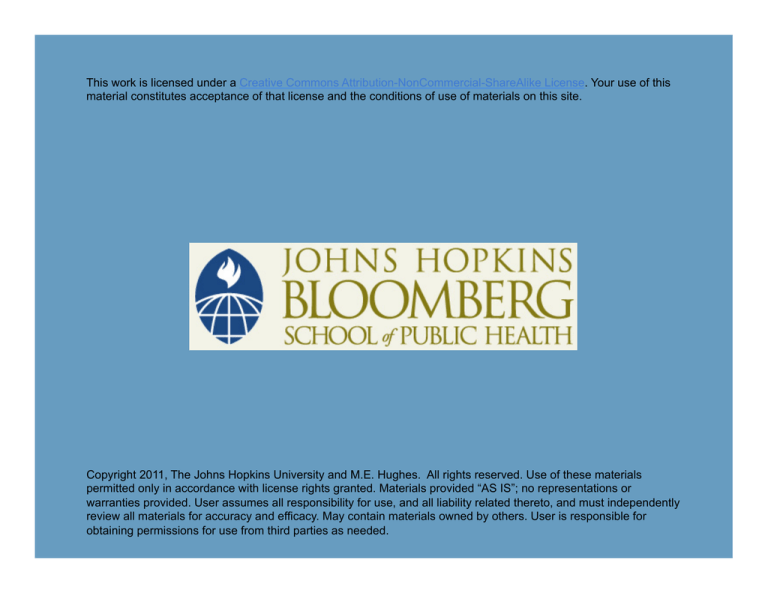
This work is licensed under a Creative Commons Attribution-NonCommercial-ShareAlike License. Your use of this
material constitutes acceptance of that license and the conditions of use of materials on this site.
Copyright 2011, The Johns Hopkins University and M.E. Hughes. All rights reserved. Use of these materials
permitted only in accordance with license rights granted. Materials provided “AS IS”; no representations or
warranties provided. User assumes all responsibility for use, and all liability related thereto, and must independently
review all materials for accuracy and efficacy. May contain materials owned by others. User is responsible for
obtaining permissions for use from third parties as needed.
Section B
Health in Later Life
Development, Aging, and Health
Most ideas about old age include some idea of health decline
So to some extent developmental stage defined by health instead of
the reverse
If old age is defined by declines in health, can an older adult ever
be considered healthy?
3
What Is Health in Later Life?
Survival
Free of diseases, conditions, and impairments
Able to function independently
Able to maintain quality of life
Meaning of last two may depend on economic and cultural context
4
Unique Features of Health in Later Life
Older adults often characterized by complex combinations of
disease—often chronic diseases
Functional impairments also may be present
“Multi-morbidities” can present challenges for medical guidelines
Typical “disease” measures often replaced by measures of function
and disability
5
Specific Indicators of Health in Later Life
Chronic diseases and conditions
Mental health
Cognitive impairments/functioning
Physical impairments/functional limitations
Disability
Frailty
Comorbidity
6
Health Outcomes Included in Contemporary Demographic Surveys
Source: Crimmins, E., and Seeman, T. (2001). Integrating biology into demographic research on health and aging
(with a focus on the MacArthur study of successful aging). In C. E. Finch, J. W. Vaupel, and K. Kinsella (Eds.), Cells
and surveys: Should biological measures be included in social science research? (pp. 9–41). The National Research
Council, Committee on Population.
7
Health Care in the Context of Aging
Emergency/sickness care, like younger adults
Increased need for various levels of care, potentially for long
periods of time
Importance of informal care
8
Disability
Defined as difficulty (or dependence) in doing activities that are
essential to independent living
- Self-care (ADLs)
- Activities associated with living independently at home (IADLs)
- Quality of life activities
Work disability refers to inability to perform work role
Primarily the result of disease or age-related change
- Sometimes slow, progressive development
- Sometimes acute change (e.g., fall)
Source: Fried et al. (2004). Untangling the concepts of disability, frailty, and comorbidity: Implications for
improved targeting and care. The Journals of Gerontology: Medical Sciences, 59A, 3, 255–263.
9
Extra-individual Factors
Extra-Individual Factors
Medical Care & Rehab
Medications & Other Therapies
External Supports
Built, Physical, & Social Environment
The Main Pathway
Pathology
Impairments
Functional Limits
Disability
Intra-Individual Factors
Risk Factors
Lifestyle & Behavior Changes
Psychosocial Attributes & Coping
Activity Accommodations
Adapted from: Verbrugge and Jette. (1994).
10
Extra-individual Factors
The Main Pathway
Pathology
Impairments
Adapted from: Verbrugge and Jette. (1994).
Functional Limits
Disability
11
Extra-individual Factors
Intra-Individual Factors
Risk Factors
Lifestyle & Behavior Changes
Psychosocial Attributes & Coping
Activity Accommodations
Adapted from: Verbrugge and Jette. (1994).
12
Extra-individual Factors
Extra-Individual Factors
Medical Care & Rehab
Medications & Other Therapies
External Supports
Built, Physical, & Social Environment
Adapted from: Verbrugge and Jette. (1994).
13
Measuring Disability
Can be assessed both by self-report questionnaire and by
performance evaluations
14
Frailty
“Frailty can be defined as a physiologic state of increased
vulnerability to stressors that results from decreased physiologic
reserves, and even dysregulation, of multiple physiologic systems.
This decreased reserve results in difficulty maintaining homeostasis
in the face of perturbations.”
Not context dependent
15
Cycle of Frailty
16
Measuring Frailty
Characteristics of Frailty
Cardiovascular Health Study Measure
Shrinking: Weight loss (unintentional);
Sarcopenia (loss of muscle mass)
Baseline: >10 lbs lost unintentionally in prior
year
Weakness
Grip strength: lowest 20% (by gender and BMI)
Poor endurance; Exhaustion
Self-report
Slowness
Walking time/15 feet: slowest 20% (by gender
and height)
Low activity
kcals/week: lowest 20%
Males: <383 kcals/wk
Females: <270 kcals/wk
Presence of Frailty
Positive for frailty phenotype: ≥ 3 criteria present
Intermediate or prefrail: 1 or 2 criteria present
Adapted from: Fried, L. P., Tangen, C. M., Walston, J. et al. (2001). Frailty in older adults: Evidence for a
phenotype. The Journals of Gerontology: Medical Sciences, 56A, 3, M146–M156.
17
Results
Frailty diagnosis was predictive of falls, declines in function,
hospitalization, and mortality
Frailty was also associated with lower education and income
Researchers are now focusing on the biological processes (i.e.,
etiology) underlying frailty
- Frailty etiology
18

